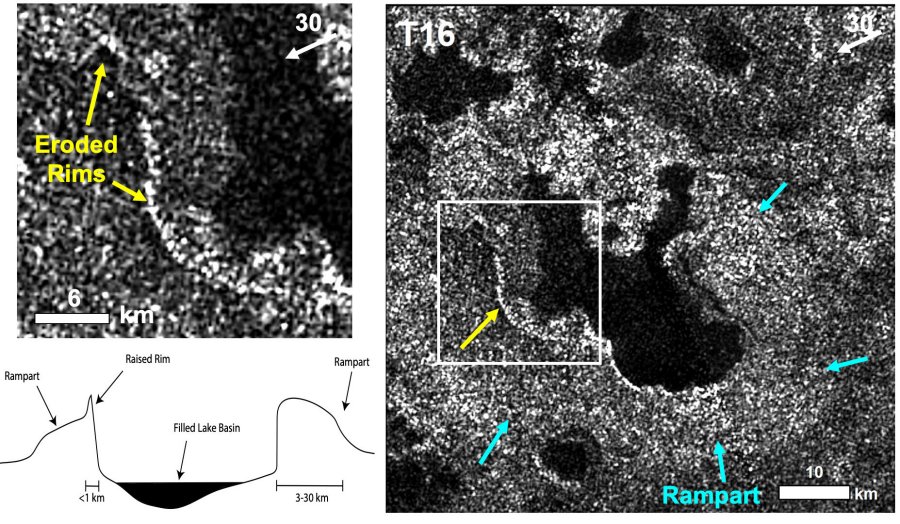Eddie Gonzales Jr. – MessageToEagle.com – Using observations from the international Cassini spacecraft, scientists have explored the ring-like mounds that wrap around some of the pools found at the poles of Saturn’s largest moon, Titan.

“The formation of Titan’s lakes, and their surrounding features, remains an open question,” Anezina Solomonidou, an ESA research fellow at the European Space Astronomy Centre (ESAC) near Madrid, Spain, and lead author of a new study into Titan’s ramparts, said in a press release.
“Ramparts may hold important clues about how the lake-filled polar regions of Titan became what we see today. Previous research revealed their existence, but how did they form?”
“The spectral data showed that ramparts have a different composition with respect to their surroundings.” adds Solomonidou. Most of Titan’s smaller lakes have appearance of sharp-edged depressions, either empty or full, with relatively flat floors, depths of up to 600 m, and steep, narrow outer rims roughly 1 km in width.

Some lakes, however, are surrounded by ramparts: ring-shaped mounds that extend for tens of km from a lake’s shoreline. Unlike rims, these ramparts totally enclose their host lake.
Using spectral and radar data from Cassini for the first tim, researchers explored five regions near Titan’s north pole with filled lakes and raised ramparts, and three empty lakes from a nearby region. The lakes ranged from 30 to 670 square km in size, and were entirely surrounded by 200 to 300 m-high ramparts that sprawled outwards from the lake perimeters for up to 30 km.
“The floors of empty lakes we studied also seem to be spectrally similar to the ramparts, suggesting that both empty basins and ramparts may be made from, or coated with, similar material, and may thus have formed in a similar way,” Solomonidou explained
Another important and widespread feature seen on Titan, which scientists refer to as labyrinth terrain. A maze-like landscape scored with different channels formed by fluvial erosion over time, labyrinth terrain is suspected to be rich in organics, rather than made of water ice. The observed similarity suggests that ramparts may be rich in organics, too.
“Ramparts are also consistently complete: while rims and other features have been worn away and broken up over time, ramparts always completely encircle their lake,” added Le Gall. “This helps us to constrain the scenarios of how they might have formed.”
The new study suggests two possible mechanisms in which such ramparts may be created: either a process involving a subsurface that is saturated with groundwater, given the differences in elevation between the empty lake floors and the filled lakes, or one in which the basin of and crust surrounding a lake first harden and then deflate, leading the lake to percolate down into the subsurface, and leaving a region of the lake basin protruding above the surrounding terrain to form a rampart.
Written by Eddie Gonzales Jr. – MessageToEagle.com Staff






